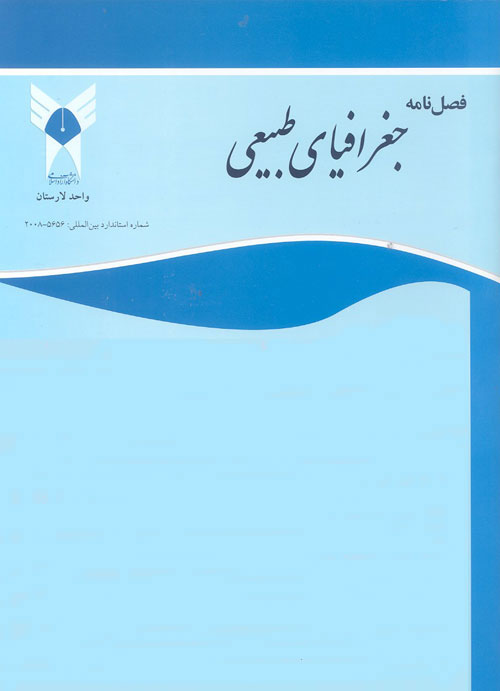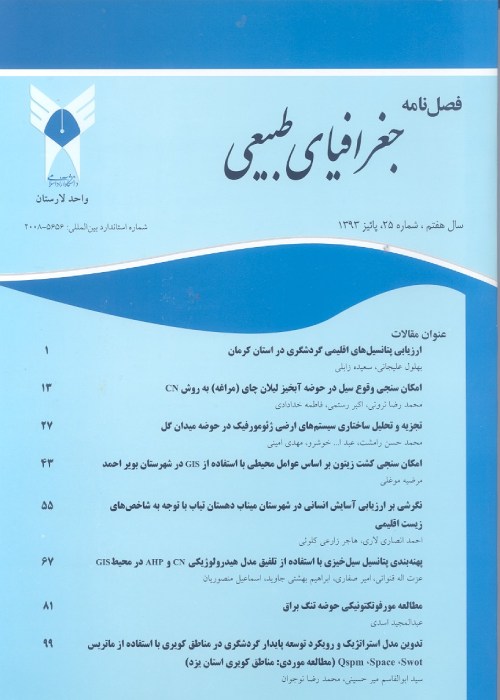فهرست مطالب

فصلنامه جغرافیای طبیعی
پیاپی 19 (بهار 1392)
- تاریخ انتشار: 1392/03/20
- تعداد عناوین: 8
-
ارزیابی کمی و کیفی منابع آب زیرزمینی جهت استفاده در سیستمهای آبیاری / (مطالعه موردی: دشته ای جنوبی و جنوب شرقی استان فارس)صفحه 33
-
نقش مخاطرات طبیعی (خشکسالی کشاورزی) در مهاجرت روستایی، با استفاده از روش (SAW) / نمونه موردی: دهستان شهدا شهرستان بهشهرصفحه 85
-
Page 1The phenomenon of heat waves is one of the most influential meteorological conditions, placing an extremely noticeable impact on the ecosystem and different human activities. It can also give rise to economic issues and increased mortality. Using descriptive and analytic instrumentation, this article aims to identify and classify the heat waves and their spatial distribution in Guilan Province, Iran. The study includes two parts. The first section deals with the days which have high-heat tensions and the second part discusses the periods of heat waves. The measuring scale is based on 1 (minor) to 5 (extreme). The findings indicate that the low-lying stations and those near the shores (except for Anzali Port) have the highest heat waves and the mountainous stations and those far from the moist shores (except for Manjil City) have the lowest distribution for heat waves. The fifth rank of heat waves has the highest heat wave distribution followed by the third, second, fourth and first ranks. Due to their highest level of moisture, Astara, Rasht, Lahijan and Kiashahr have the highest heat wave distribution and so are the hottest cities, but Anzali is the coolest port city.Keywords: Climatic changes, Guilan Province, Heat tension, Heat waves, Extreme hazards
-
Page 17Nowadays, Tourism is considered one of the biggest and most venous industries all over the world. About 8 percent of world trade business is related to it and in more than 60 countries in the world tourism is the most important source of business related to foreign financial income. Geotourism in recent decade has had significant progress. In about one third of third world countires it is taken into account as one of the Nosrat Abad village (also known as Takht-e Soleyman) in a distance of 40 Km far from Takab town located in west Azerbaijan, is the fourth Iranian registered monument in UNESCO. Takht-e Soleyman as a historical complex including the most important fire place of Sasanian ranges and fighters of as well as its special morphological structure of limy mountain is viewed with a very high potential of various geomorpholical of limy mountain is viewed with a very high potential of various geomorpholical bodies such as verities of karst land form which has added extra spectacular and panoramic landscape to it. In fact existence of this geomorpholical land form beside that historical complex has made this small area to one of the most important location of tourism in west Azerbaijan.Keywords: West Azerbaijan, Takht-e Soleiman, Geotourism, Tourism, Swot model
-
Qualitative and Quantitative Assessment of Groundwater Resources for Irrigation Systems / (Case Study: Southern and Southeast Plains of Fars Province)Page 33Management of water resources for optimum usage is one of the most important issues of sustainable development. In this research, Southern and Southeast Plains of Fars Province was selected to consider the trend of qualitative and quantitative of groundwater. 83 wells in Farashband, GhiroKarzin, Khonj, Lar, Lamerd and Mohr were selected and the raining status in the statistical period of 30 years and also the trend of qualitative and quantitative ground water in the period of 2006 to 2010 was investigated using qualitative indicators.The results showed that, generally, it has caused to increase the concentration of sulfate, pH, sodium absorption ratio (SAR) and chloride and this shows the effect of drought on water quality. Also, analyzing the quality of ground water resources for irrigation systems. The results shows the reduction both of rainfall and excessive offtake of groundwater and groundwater levels particularly in recent years water quality status in this area has also decreased. So based on the water classification, selected plains water is not suitable for irrigation. Lar, Lamerd, Khonj and Mohr plains are in the critical conditions and management strategies are recommended for the irrigation systems.Keywords: Groundwater, Water quality, Water salinity, Wilcox Classification, Irrigation systems
-
Page 45One of most effective factors on life of an area is its climate type so that dispersion of types of plants and animals has a tight relationship with climatic condition of every area¡thus understanding of climate type of an area and effective elements that are determinant of climate of that area is preferable so climatic division or understanding of climatic flattening is sensory for planning in order to optimal exploitation and area utilization. Hence the purpose of this study is to identify environmental powers and the most important climatic elements influencing on climate of yazd and to separate locally climatic sub areas of yazd by using modern statistical methods. In this article, climatic Regionalization of yazd is performed by multivariate methods and features of every climate is separately stated. For accessing to this purpose, statictcal data of 28 atmospheric variables related to 25 barometric stations were elicited from aerology organization, that they provided annual average of 27 climatic elements of 25 barometric stations of yazd. This matrix was averegged 25×27 as small as cell (pixcel) 15×15 kilometric by kriching method and changed to matrix 27×579. Then modern methods based on base components analysis and cluster analysis techniques were used¡ by applying base components analysis on matrix, correlation of data matrix showed that we can describe 99/3 % dispersion of data by six components. First component is humidity- windy elements determine the highest dispersion of data (43/8) that quantity profile of yazd is shown as following by this method according to importance of element: Temperature-humidity component, precipitation-humidity component, dusty component, windy component. By applying hierarchical cluster analysis and integration method on score of components, climate areas of yazd were divided to six areas including: 1- moderate and relativly arid climate of Abarkooh - Harat 2- moderate and arid and dusty climate of Shirkuh 3-Semi warm and hyper arid climate of Yazd_Bafgh 4-warm, hyper arid and dusty climate of Tabas 5-Semi warm and arid climate of Dastgerdan 6- Semi warm and arid climate of Dey hook.Keywords: Climatic regionalization, Principle component analysis, Cluster analysis, Climate region, Yazd province
-
Page 59Atmospheric general circulation models, due to the large scale of their computing networks, able to predict the parameters of water and weather are not the point scale, So scientists interface tool called the Weather Generator model was developed that can based on the use of cholera numerical model output, the climate change Vaystgah point scale meteorological study and evaluation contract. GCM outputs used in this study, data from the model ECHO-G is under the A1 scenario. and the results on the eight synoptic stations including Khuzestan, Abadan, Ahvaz, Bostan, Dezful, Masjed Soleiman, Omidiyeh, and Ramhormoz was Safi-Abad . The results of comparing the values of the 2005-1986 monitoring compliance Vmdl significant and suggests that the ability of climate models to simulate data. Model output was determined by examining the area of study is very different responses to climate change0 Values and monitor the results of modeling three arguments, minimum temperature and maximum monthly temperature show that the greatest increase in minimum temperature in Abadan station 18.8 ° C, maximum temperature reduction station Hdaksrdr Bostan -1.8 ° C, Most rainfall Ramhormoz station with 1.03 mm in the period 2010-2029 has been statistically. The results also suggest that the greatest change in Nsrbarsh in Srasrmntqh studies. A total of eight stations studied, with annual rainfall will increase with decreasing temperature .Keywords: climate change, models GCM, Downscaling, climate change scenario, Weather Generator, The study area
-
Page 71The Ardabil city area has more than 2398 km2 with 504946 residuals. The procedure of increasing of people and ratio of urban land use according to the drought (especially 1371 to 1387), immigration of rural people to the Ardabil and so becoming Ardabil as a province center in 1372 are intensified. Water consumes per capita in the developing and semi arid zone estimated between 150 to 200 liter. Water consume per capita in the Ardabil city in per day 10098920 liter/day and annually of them about 398610580 liter(368610/58 m3) are estimated. In addition water necessary of Ardabil plain in the Agriculture, industrial sections 588000000 m are estimated. The total water potential (grand and surface waters or runoffs) is estimated about 256000000 m3. To day the water deficient of plain is 347000000 m3 is the more important factors in the subsidence of Ardabil plain. Extensive extraction of water, Climatic change, ratio of people increasing, industrial developing and tectonic variation respectively have vital roll in the subsidence of the Ardabil plain.Keywords: Ardabil plain, Water deficient, Subsidence, Climate change, Geo hydrology, Ardabil city
-
Page 85From the 1980s onwards, the relationship between vulnerability to natural hazards and development, more attention has been Initially, the development focus was mainly on the effects of hazards And the later effects of development on natural hazard-related damage was considered. As one of the most important issues in studying natural disasters and drought impact on agriculture, rural migration, etc. is In recent decades has been studied, such as floods, famine, earthquakes, economic development communities in all levels endanger And directly through changes in population abundance or availability of food, clothing, water and energy resources will be affected The close relationship with the natural environment and rural communities due to limited power, Long in comparison with other communities, have been more exposed to natural destructive forces. To deal with natural hazards, particularly drought and agriculture, the direct and indirect impacts on the community, there is a significant challenge in the development process. The migration of the Yi village complete destruction of the underlying national prosperity and loss of freedom that leads to the decline of rural civilization The law guarantees citizens freedom and dignity of human civilization. Research method was descriptive and analytic. Present study, in order to recognize the indicators cultural character in rural areas, one hundred twenty of rural people and ten villages were randomly selected to fill out questionnaires. Then through SPSS software. The results was of the study show, we can accepted that between as natural hazards and rural migration there is mining full relationship and more impacts is in see rural: arzat.Keywords: Drought, Migration, Rural Development, Behshar
-
Page 99There are different methods to measure evapotranspiration, that FAO Penman Montys is important. In Iran, this method used to estimate evapotranspiration. But there is not possibility of using this method in some area due to lack of meteorological data. There for, this study compares the evapotranspiration calculated by the Belany krydl, Jensen Hayes, reform Jensen Hayes and Hargreaves Samani to FAO penman mantis method and limiter in Sistan plain than the way has been identified to be most correlated with the FAO penman mantis. The results shown that Belany Krydl has maximum correlation coefficient ( ) (0.973 and 0.971) and Hargreaves method has minimum correlation coefficient (0.75 and 0.69) than other methods of calculating evapotranspiration.Keywords: Evapotranspiration, Limiter, FAO penman mantys, Sistan.


